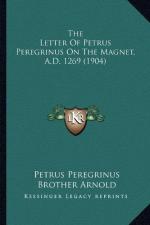|
This section contains 389 words (approx. 2 pages at 300 words per page) |
Encyclopedia of World Biography on Petrus Peregrinus
Petrus Peregrinus (active 1261-1269) was a French scholastic and scientist whose famous letter on magnetism is one of the monuments of experimental research in the Middle Ages.
Only the scantiest details are known about the life of Petrus Peregrinus, also known as Pierre de Maricourt. He very probably studied at the University of Paris. He wrote a treatise on the astrolabe, Nova compositio astrolabii particularis, after 1261.
In 1269, when he wrote the letter which won him lasting renown, Peregrinus was in the French army of the crusaders who were attacking Lucera, a city in southern Italy. Like Archimedes in ancient Syracuse, Peregrinus was engaged in military engineering, such as the making of machines to sling stones and fireballs against Lucera.
While working on such military problems, Peregrinus was led to wonder about the possibility of keeping a machine in perpetual motion. He worked on this question by diagraming a wheel that would be turned perpetually by a magnet. To explain his novel theories to a friend at home, Peregrinus wrote the Epistola and Sigerum de Foucaucourt miletum de magnete in August 1269, outlining his observations and theories on magnetism. Because the recipient, addressed as "the dearest of friends," was not a learned man, Peregrinus had to instruct him in fundamentals. Anticipating what was to be the standardized science of only a much later period, these fundamentals were not only right for the most part but were also influential on other writers. Peregrinus is thus transitional between medieval and modern science.
Among the more important observations and theories of Peregrinus concerning the magnet were the identification of the polarity, north and south, in a magnet and the generalization that like poles repel and unlike poles attract; the recognition that any portion of a magnet is a magnet (a remote anticipation of the modern molecular theory of magnetism); the discovery that stronger magnets can neutralize weaker ones; the construction of a magnetized needle pivoted in a circle (an anticipation of the compass, which was to be developed 50 years later); and the use of a magnet to drive a wheel, thus adumbrating the magnetic motor. Though seeing magnetism everywhere on the globe, Peregrinus did not draw the conclusion that the earth was magnetic. He held that from the north and south poles of the heavens "the poles of lodestone derive their virtue."
|
This section contains 389 words (approx. 2 pages at 300 words per page) |


